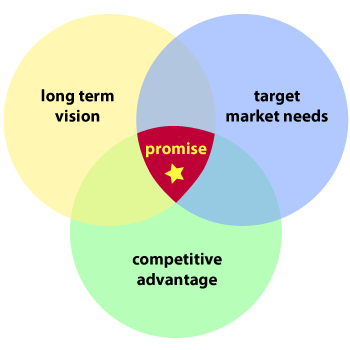Few education companies do marketing well. Many are good at sales and distribution, others are product driven and innovative, but very few are able to drive high growth through world class marketing.
What does great marketing look like?
* Reps have so many leads they triage them.
* Customers recommend you to all their friends.
* Annual growth consistently beats your peers – your market share is growing.
There are two core questions that constitute what I call “Big M Marketing.”
![]() 1. What promise are you making to the market?
1. What promise are you making to the market?
2. How are you aligning the entire business to fulfill the promise?
The first question drives the strategic vision and the second drives the tactical execution. Yin and yang – you have to embrace both.
 It really is this simple – but simplicity is difficult for most companies. You must put the time in up front to get the promise nailed down and then you have to sustain your focus on it long enough for the market to believe you.
It really is this simple – but simplicity is difficult for most companies. You must put the time in up front to get the promise nailed down and then you have to sustain your focus on it long enough for the market to believe you.
So how can you get away from empty sloganeering, sales support masquerading as marketing (you need both), and pin-the-tail-on-the-donkey marcom? Here is a brief overview of one way to start doing Big M Marketing.
Developing a winning promise requires three things.
1. Understanding what business you are in.
2. A clearly defined target market and a deep understanding of their needs.
3. A comprehensive view of the competitive arena.
With these elements in place it is possible to create a promise that is believable, meets urgent customer needs, and provides a competitive advantage. The promise is found at the intersection of these three elements.

With a great promise in hand you are less than halfway there.
 Aligning the entire business to fulfill the promise is where the magic happens. This takes commitment from the entire leadership team in a company and for this reason it is critical that the promise is developed as a team. If the day-to-day decisions in a business are tightly aligned every contact a customer has with the company reinforces the promise.
Aligning the entire business to fulfill the promise is where the magic happens. This takes commitment from the entire leadership team in a company and for this reason it is critical that the promise is developed as a team. If the day-to-day decisions in a business are tightly aligned every contact a customer has with the company reinforces the promise.
What does this look like in practice? Here are three examples.
Company A is working with on-line student information. Data security has to be part of their core promise. They host the application in a military level security facility, form alliances with government agencies promoting on-line safety, and provide training and sample policies to their customers that will help make the system more secure.
Company B determines that their customers want to deal with a company that shoots straight. To accomplish this they put in place pricing policies that are transparent, they don’t engage in bait and switch discounting models, they invest in a customer blog that is actively managed and open to all comments, and they reward and recognize employees who live up to this ideal.
Company C buyers have changed from site based decision makers to district office staff. They develop pricing models that reward district wide purchases. They design in ways for central office personnel to get district wide reports so they can gauge progress. The hire ex-superintendents to provide sales support and access. They develop a catalog organized around educational research not products so that administrators can find what will work best for their district easily.
Notice that all of these examples I did not provide slogans, I provided a list of concrete actions the companies took to make their promise real. Slogans are important for quickly communicating the promise in a noisy market. But if your actions are well aligned you will still be doing great marketing even without a slogan.
Please don’t misinterpret this as denigrating Sales and Product Development/Editorial. You also need world class sales and product development for this to work. Marketing can’t overcome a weak sales force or crappy products. If this is about making a promise you have to build products that fulfill the promise and you have to have sales people who can communicate the promise with passion. Its all about balancing these elements.
What do you see when companies are not doing this well?
Sales people saying things like “oh thats just marketing.” The company will engage in a lot of “hail Mary” marketing – tossing out long shot campaigns when things are not going well. Oh, and no one will trust the Marketing Department because they change their message every 6-8 weeks.
Once the promise is mapped out it becomes how the company does business for years.
It is your actions not your words that customers believe in the 21st Century.
 The Education Business Blog
The Education Business Blog

